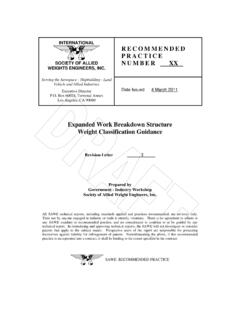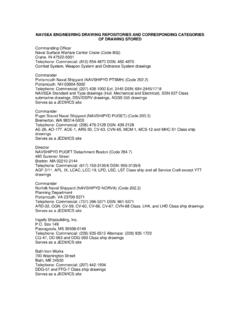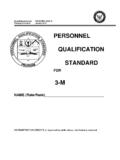Transcription of Methods of Determining the Weight Distribution of Ships
1 Methods of Determining the Longitudinal Weight Distribution of a Ship David Laurence Hansch, naval Architect Northrop Grumman newport News For Presentation at a Joint Meeting between the Hampton Roads Section of the Society of naval Architects and Marine Engineers Hampton Roads Chapter of the Society of Allied Weight Engineers Presented January 24th 2008 Abstract Approximation Methods for Weight Distribution of Ships are surveyed. Grouping Methods such as the Bucket and station method are also explored. Detail based Methods are explained. Finally, an improved method of Distribution based on details is proposed. Guidance for the requirements of a Weight database for this method is given and an alternative summary method is suggested to overcome difficulties caused by failure to meet certain database requirements of the detail method. Extensive appendices provide necessary figures and equations for using these Methods .
2 Contents The Weight Distribution Approximation Grouping Direct Distribution General Philosophy of Mechanics of An Improved Direct Distribution Validating the Database Requirements for Direct Distribution Summary Accuracy of Weight Appendix A: Survey of Approximate Methods of Weight Appendix B: Equations for the Direct Calculation of Weight 2 Introduction Determination of the longitudinal Weight Distribution is vital to the proper calculation of the longitudinal strength of a ship. The longitudinal Weight Distribution also affects speed loss in a seaway [1]. Weight distributions of all three principal axes can also be used to calculate the ship s gyradii [2] which have a profound effect on the seakeeping performance of a vessel. Before the advent of computers, determination of a ship s Weight Distribution was a rather laborious process [3]. Due to the amount of labor involved, approximation Methods were developed over the years.
3 With the advent of computers, Methods of collecting all of the weights with centers between given locations became less labor intensive giving rise to grouping Methods . For longitudinal strength calculations, various levels of detail are acceptable. However, the standard is a Twenty Station Weight Distribution which actually consists of 22 Weight segments divided by 21 stations, (Stations 0 through 20). The Weight Distribution Problem Weight distributions are needed for numerous uses however Weight data is stored in databases as large numbers of discrete details. These details are essentially lumped masses and can represent items which extend for large portions of the length of the vessel. The traditional response to the need for Weight distributions is to use a stock approximation appropriate for the ship type and improve it by distributing the large Weight items separately. After the computer revolutionized the storing of Weight data, the goal of assigning individual Weight items to each station of the Weight Distribution began to be feasible leading to the grouping Methods .
4 However, even highly detailed Weight databases often use Weight details which are too long longitudinally for such Methods to be wholly effective. This gave rise to the goal of distributing each Weight record and then combining these distributions. Realization of this goal requires inclusion of the extents of each Weight record in the database. Unfortunately the extents are not always included for a multitude of reasons. This paper surveys all of the Methods mentioned thus far and recommends an ideal detail Distribution method and guidelines for a database which would make this method feasible. It also explains a summary based method which enables the user to use the same Weight Distribution techniques proposed for the detail Distribution method with a database which does not contain all of the data necessary to distribute individual details. 3 Approximation Methods Numerous approximation Methods for distributing hull Weight have been proposed in the past.
5 Hull Weight is traditionally defined as lightship minus the Weight of the anchor, chain, anchor handling gear, steering gear and main propulsion machinery. Determination of the exact breakdown of hull Weight should be made based on the relative density of the object in question. Items left out of hull Weight should be independently distributed as rectangles or trapezoids and combined with the hull Weight Distribution to determine the total Weight Distribution for the ship. Most approximation Methods are based on combinations of a midship rectangle with forward and after trapezoids. More sophisticated Methods base a portion of the Weight curve on the ship s buoyancy curve. Approximation Methods are presented in works by Smith [3], Comstock [4], and Hughes [5] as well as in Principles of naval Architecture [6]. Appendix A: Survey of Approximate Methods of Weight Distribution contains details and equations for several of these approximations. These approximations are general and appropriate only for initial stage design due to their low fidelity.
6 An example of such an approximation is depicted in Figure 1. Figure 1: One Example of an Approximate Weight Distribution . Source [4] Marine Vehicle Weight Engineering [7] contains longitudinal Weight distributions by type for various military and support vessels. This segregation of distributions by type allows for improved fidelity. Such base distributions can be grossly modified to quickly arrive at a Weight Distribution of new designs similar to the provided types in the concept exploration stage of design. However, the resultant distributions are still not accurate enough for final longitudinal strength calculations. 4 Grouping Methods The original grouping method is the Bucket method. The Bucket method derives its name from the fact that the Weight details are metaphorically placed in buckets based on the location of their longitudinal center of gravity. If a line item s longitudinal center of gravity falls in the extents of a bucket, it is included in that bucket.
7 This method is illustrated in Figure 2. Figure 2: An Illustration of the "Bucket Method" The flaw of this method is that Weight details are lumped representations of distributed weights. One line item can represent 1 or 1000 feet longitudinally. Thus just because the center reported in the line falls in one bucket does not necessarily mean that all or even the majority of the Weight reported in that line falls in that bucket. Generally the most offending line items in such a method are items such as paint, weld, and mill tolerance weights as they generally reflect the Weight of these items across the entire ship. Weights such as these are generally corrected by hand to improve the Distribution . However, most other weights that belong in multiple buckets remain uncorrected. Distributed systems such as piping, electrical and ventilation systems often have Weight records that have extents that span multiple stations. Thus the accuracy of this method is limited.
8 The Ship Design Weight Estimate program used by NAVSEA utilizes an extra field in the Weight record allowing the Weight calculator to indicate whether the Weight represented by that line resides in only the station it is in, is distributed over a number of stations about the record s center, or is spread over the entire ship [8]. This station method improves the quality of the Weight Distribution and reduces the amount of rework needed to yield a reasonable Distribution . It should be noted that this improvement only masks the inherent flaw of this approach; it does not eliminate it. 5 Direct Distribution Methods General Philosophy of Distribution The approach that offers the most promise is distributing the individual Weight records directly. The Distribution of each Weight record can then be summed to determine the Weight Distribution of the entire ship at a fairly high level of fidelity. This whole ship Distribution can then be used to create any representation of the Weight Distribution , such as the Twenty Station Weight Distribution .
9 Mechanics of Distribution The fundamental representative shape of direct Distribution Methods is the trapezoid. Representing a Weight record as a trapezoid requires knowing the Weight , the longitudinal extents, and the longitudinal center of the Weight being represented. The computer program ShipWeight created by BAS engineering uses such an approach [9]. The fundamental problem with trapezoidal representations is that they are limited to Weight records where the center resides in the middle one third of the length. Attempts to represent Weight records whose center falls outside of the middle one third using the equations for trapezoidal representations result in part of the Weight distributions being negative. Such an inverted trapezoid is portrayed in Figure 3. Figure 3: The result of attempting to use a trapezoid to represent a record whose center is outside the center 1/3. Such a representation is clearly flawed as it subtracts Weight from a location that the record should be adding Weight to.
10 This can be overcome by requiring that the user adjust the inputs so that the center falls in the middle one third of the extents. This is accomplished by dividing the offending records into acceptable pieces or combining them with other records to create acceptable records and can involve a large amount of user interaction with the tool. Another option is to simply adjust the extents outward until the center is in the middle one third. Unfortunately, this option often reduces the accuracy of the resultant Distribution . 6 An Improved Direct Distribution Method Before exploring refinements to the direct Distribution method, it is informative to consider what is desired from a method and its resultant Distribution . First, the method should require a minimum of inputs. A reasonable set of inputs consists of a description of the item, the Weight , longitudinal center of gravity and the forward and after longitudinal extents. Obviously a high degree of fidelity in the resulting Distribution is desired; particularly, the Weight per foot evaluation interval should be far smaller than the station length.






